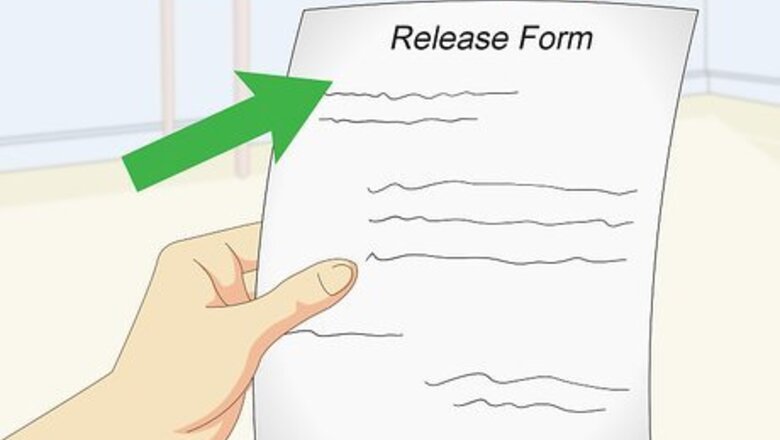
views
Preparing for the Shot
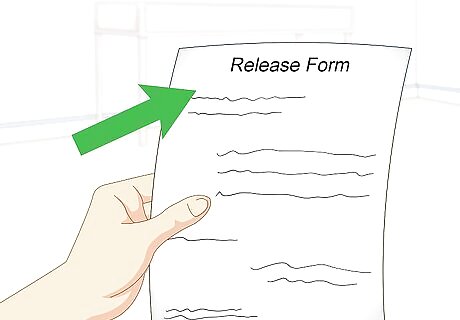
Review the release forms. When you purchase vaccinations or other medicines from a veterinarian to administer yourself, you will have to sign a release form. Read this form carefully. Not only does it provide valuable information, it helps you understand your responsibilities when you decide to administer shots yourself. By signing the release form, you accept full responsibility for your pet's injection and any reactions or accident that might occur. It warns that allergic or other life-threatening reactions can occur even if the shot is administered correctly. The form warns the shot may be ineffective if it is outdated, left unrefrigerated too long, improperly administered, or exposed to heat, sunlight, or freezing temperatures. Some forms state that if you administer your own rabies vaccine, it will not be accepted as valid by law enforcement agencies and animal care professionals. Make sure you know if this clause is present in your form and its repercussions. Your dog will legally be considered unvaccinated for rabies, which means many kennels will not let your board there and you may not be able to adopt other dogs from animal shelters depending on their policies.
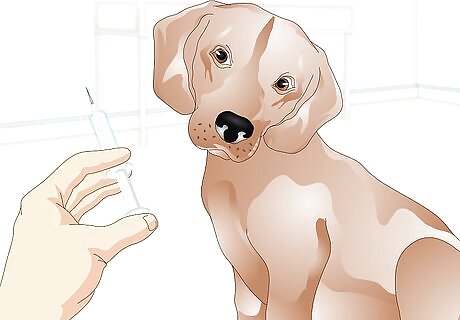
Introduce your dog to the syringe beforehand. If your dog has previously been given shots at a vet's office, they probably associate syringes with pain and discomfort. To combat this, allow them to look at, sniff, and paw at an empty syringe (with no attached needle) at a comfortable place in your home. Give treats and other forms of positive reinforcement during these sessions, such as attention, praise, and play. You want your dog to associate the syringe with positive moments to reduce fear and stress when you actually administer the shot.
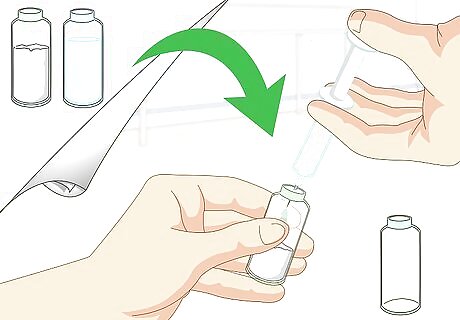
Combine the liquid and powder. Some substances used in shots, especially vaccines, come in two vials: a liquid vial and a powder vial. The liquid and powder needs to be mixed before the shot is administered. Insert the syringe's needle into the liquid vial and pull up the plunger until all the liquid is in the syringe. Push the syringe into the vial containing the powder. Make sure all the liquid empties before pulling out the syringe. Shake the vial. Make sure the powder is completely dissolved. There should be no clumps or residue collected at the bottom of the vial.
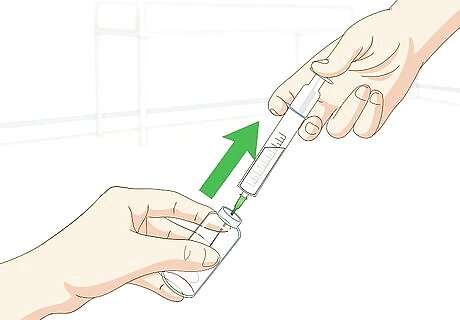
Draw the desired amount. You should know how many milliliters of medicine or vaccination you are administering to your dog. Before giving him the shot, draw out that amount. Insert the syringe into the combined liquid and powder vial. Pull up until you have the desired amount of milliliters. Make sure there are no air bubbles. If you notice any, push the syringe down, empty the vial, and try again.
Administering the Vaccination
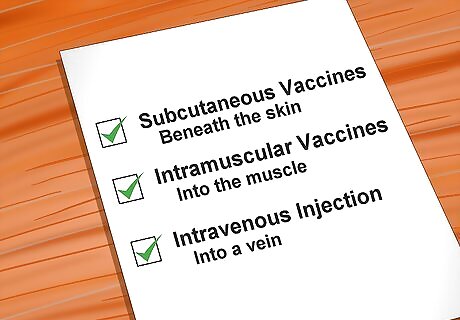
Familiarize yourself with the three types of injections. Thought there are three different types of injections given to dogs, there is only one type — subcutaneous shots — that can potentially be administered by someone other than the vet. If you shot you plan to give your dog does not fall into this category, then you must take them to the vet. Subcutaneous vaccines are given just beneath the skin. The majority of vaccines and shots are subcutaneous. These are usually administered on the loose skin just above a dog's shoulder blades. If you're administering shots yourself, always use the subcutaneous method. If the medication or vaccination specifically states it needs to be injected in another manner, take your dog to the vet's office. Intramuscular vaccines are injected into the muscle. If you're not a veterinary professional, it might be hard to locate a muscle on your own. It is best to take your dog to the vet if he needs an intramuscular vaccine. Intravenous injections must also be administered by a vet. These injections must be injected into a vein and you should not attempt to do this yourself. Vaccines are not given by IV injection.
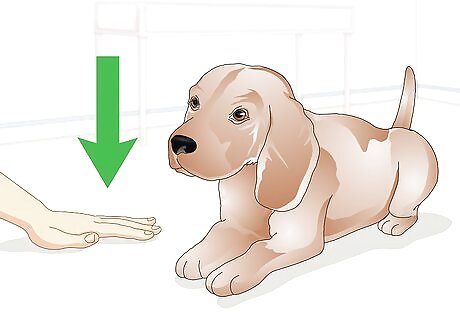
Find a flat surface. A hard, flat surface should be used when administering shots to your dog. A flat surface, such as a counter or table, allows you plenty of room while administering the medication. Find something that allows you to work comfortably. Have a friend or family member present. Even if your dog is normally calm, he might fidget or fight if he feels a prick. Someone should be present to hold the dog during the injection. This is particularly important if your dog is small and might leap off the table or counter.
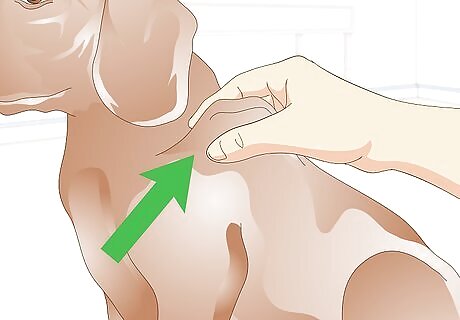
Lift the dog's skin up and form a pocket in their skin with your finger. As you'll be using a subcutaneous vaccine, it's best to administer it on the loose skin found behind the shoulder blade. Using your non-dominant hand, lift the skin upward, away from the shoulder blade. Using your index or middle finger of your dominant hand (which is holding the syringe), angle the needle at 90 degrees to the flat tented surface of the skin. Push inward to form a small pocket of skin. This reduces the risk of accidentally administering a shot into the body or catching sensitive areas.
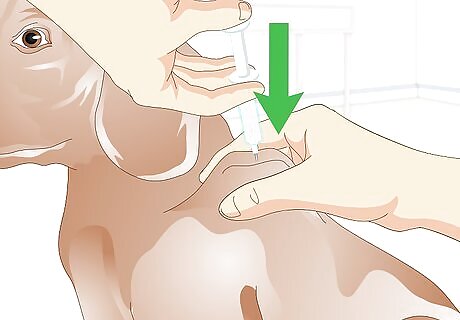
Administer the shot. Press the needle into your dog's skin. Before injecting, pull the plunger out a little bit. If you see any blood being draw, you're in a vein. This could cause harm to the dog. Pull out, refill the syringe with fresh medicine, and insert it again. Once you find a safe spot, slowly push the plunger down until all the liquid is gone.
Observing the Dog Afterwards
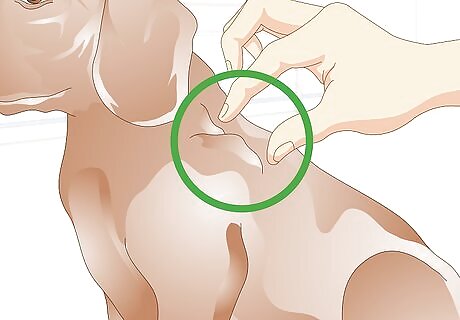
Watch for skin reactions. Some soreness after an injection is normal, but it also sometimes be a sign of infection or allergic reaction. Monitor the skin after injection for any signs of a serious reaction. Mild reactions are very common and come in the form of a lump or swelling around the site of the injection. This may last a few hours, but might also stay for up to a week. If you notice hives, rashes, or swelling that occurs anywhere outside the injection location, such as the head or shoulder blades, seek medical care. This is a sign of a severe reaction and requires medical care.
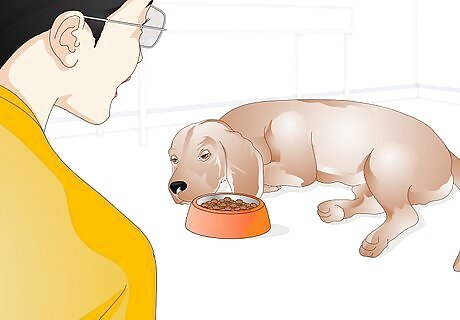
Understand reactions are common. Reactions to injections, especially vaccinations, are very common. For the most part, the benefits outweigh the risks involved. However, your dog may exhibit a number of mild symptoms that should go away within a week. Fatigue and a low grade fever are common reactions to an injection. Your dog might be lethargic and have a low appetite during the days following an injection. Your dog might also be sore in the area surrounding the injection. Be careful handling him after his shots, especially if you have any contact with his shoulder blades.
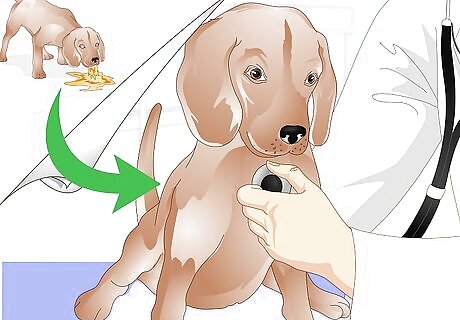
Know when you need immediate veterinary care. Severe allergic reactions are rare, but can occasionally occur. If a severe allergic reaction does occur, it will usually be within 20 - 30 minutes of giving the injection and the most common sign is collapse. If your dog exhibits any of the following symptoms, seek immediate medical care: Vomiting Diarrhea Lameness Collapse Seizure











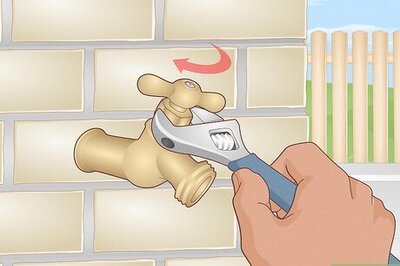




Comments
0 comment